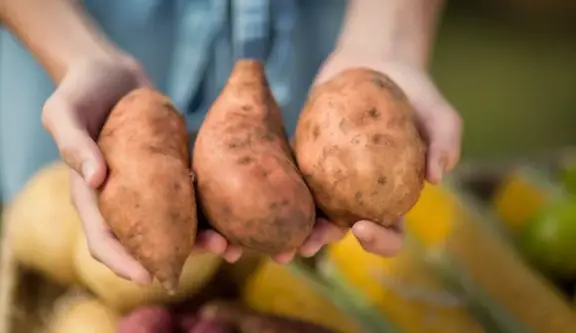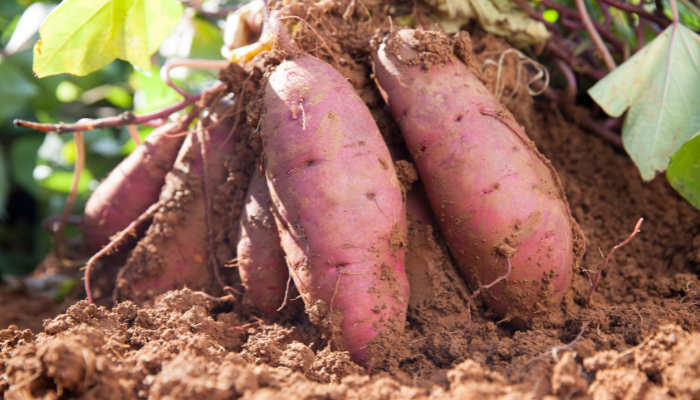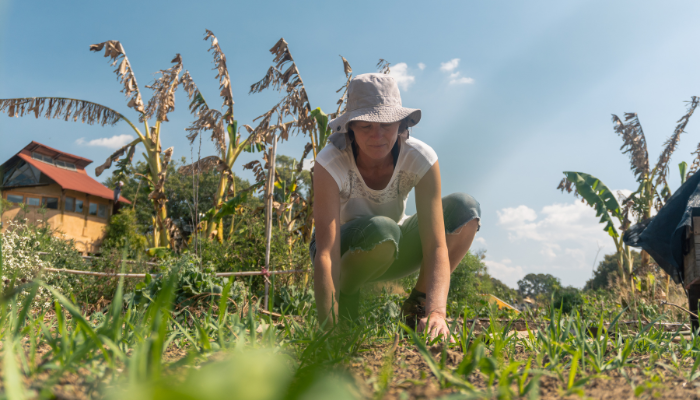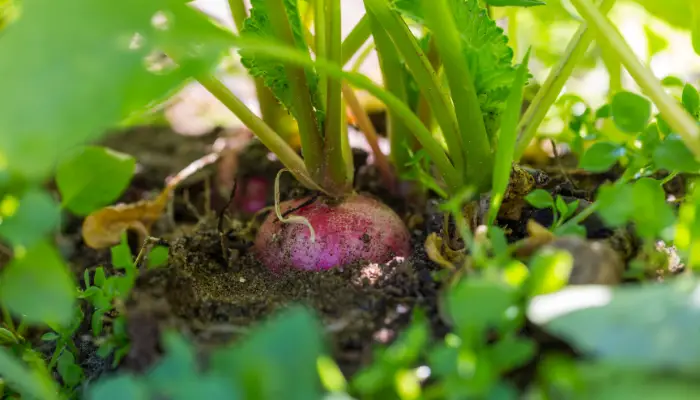What Can I Plant with Sweet Potatoes: Companion Plants and Tips
Sweet potatoes are a popular and nutritious vegetable that can be grown in many different regions. However, knowing what to plant with sweet potatoes can be a challenge for many gardeners. Companion planting is a method of growing different plants together to benefit each other, and it can be an effective way to improve the growth and yield of sweet potatoes.
When it comes to companion planting with sweet potatoes, there are several factors to consider. First, it is important to choose plants that have similar growing conditions and soil requirements. Sweet potatoes prefer well-draining soil and full sun, so plants that require similar conditions will likely do well when planted together.
Another factor to consider is pest control. Sweet potatoes can be susceptible to pests such as root-knot nematodes, so planting companion plants that repel or deter these pests can be beneficial. Additionally, some companion plants can help improve soil health and nutrient availability, which can lead to healthier sweet potato plants and a better harvest.
What are Sweet Potatoes?

Sweet potatoes are a versatile and nutritious root vegetable that can be used in a variety of dishes. They are also easy to grow and can be planted in a variety of conditions. Here are a few things to keep in mind when planting sweet potatoes:
Soil
Sweet potatoes prefer well-drained soil that is rich in organic matter. The ideal pH range is between 5.0 and 6.5. If the soil is too acidic, add lime to raise the pH. If it is too alkaline, add sulfur to lower the pH.
Companion Plants
Companion planting is a gardening technique where different plants are planted together to benefit each other. When it comes to sweet potatoes, there are a few plants that make good companions:
- Beans: Beans fix nitrogen in the soil, which is beneficial for sweet potatoes.
- Corn: Corn provides shade for sweet potatoes and helps to retain moisture in the soil.
- Peppers: Peppers deter pests that can damage sweet potatoes.
- Rosemary: Rosemary repels pests and can improve the flavor of sweet potatoes.
Planting
Sweet potatoes are usually planted in the spring, after the last frost. They can be planted directly into the ground or started indoors and transplanted.
When planting sweet potatoes, make sure to space them about 12 inches apart and plant them about 4 inches deep. If you are planting in rows, space the rows about 3 feet apart.
Harvesting
Sweet potatoes are usually ready to harvest in the fall, around 100-120 days after planting. To harvest, carefully dig up the sweet potatoes with a garden fork. Be careful not to damage the roots or the sweet potatoes themselves.
Conclusion
By understanding the basics of sweet potato planting, companion planting, and harvesting, you can grow a healthy and productive crop of sweet potatoes. Remember to pay attention to the soil, choose the right companion plants, plant at the right time, and harvest carefully to ensure a successful sweet potato harvest.
Companion Planting Basics

Companion planting is a gardening technique that involves planting different crops near each other to benefit each other. The practice has been used for centuries, and it is based on the idea that certain plants can help each other grow better, repel pests, and improve soil health.
The goal of companion planting is to create a diverse and balanced ecosystem in the garden, where plants can support each other and thrive. Companion plants can provide a range of benefits, including:
- Pest control: Some plants can repel pests or attract beneficial insects that prey on them. For example, marigolds are known to deter nematodes, while dill and parsley attract ladybugs and lacewings that eat aphids.
- Nutrient cycling: Different plants have different nutrient needs and can help each other by cycling nutrients in the soil. For example, legumes are known for their ability to fix nitrogen, which can benefit other plants in the garden.
- Soil health: Companion plants can help improve soil structure and fertility by adding organic matter and breaking up compacted soil. For example, planting cover crops like clover or vetch can improve soil health and reduce erosion.
When it comes to sweet potatoes, there are several companion plants that can be beneficial. For example, root vegetables like beets and parsnips can help break up soil and improve drainage, while beans and peas can fix nitrogen in the soil. Additionally, herbs like thyme and rosemary can repel pests and improve the flavor of sweet potatoes.
Overall, companion planting is a simple and effective way to improve the health and productivity of your garden. By planting a diverse range of crops and taking advantage of the natural synergies between them, you can create a thriving ecosystem that benefits both plants and people.
Best Plants to Grow with Sweet Potatoes

When it comes to companion planting, sweet potatoes have a few good options. Here are some of the best plants to grow with sweet potatoes:
Beans
Beans are a great companion plant for sweet potatoes. They help to fix nitrogen in the soil, which can be beneficial for the growth of sweet potatoes. In addition, beans can help to deter pests that might otherwise attack sweet potatoes. Some good varieties of beans to plant with sweet potatoes include pole beans, bush beans, and lima beans.
Corn
Corn is another good companion plant for sweet potatoes. It can help to provide shade for the sweet potatoes, which can be beneficial in hot weather. In addition, corn can help to attract beneficial insects that can help to pollinate the sweet potatoes. Some good varieties of corn to plant with sweet potatoes include sweet corn, popcorn, and ornamental corn.
Marigold
Marigold is a great companion plant for sweet potatoes. It can help to repel pests that might otherwise attack sweet potatoes. In addition, marigold can help to attract beneficial insects that can help to pollinate the sweet potatoes. Some good varieties of marigold to plant with sweet potatoes include French marigold, African marigold, and signet marigold.
Overall, these are just a few of the best plants to grow with sweet potatoes. By planting these companion plants alongside sweet potatoes, it can help to promote healthy growth and deter pests.
Plants to Avoid Planting with Sweet Potatoes
When planning a garden, it is important to consider which plants should not be planted together. Some plants can inhibit the growth of others or attract pests that can damage neighboring plants. Here are two plants that should not be planted with sweet potatoes:
Potatoes
Potatoes and sweet potatoes are both root vegetables, but they should not be planted together. They are susceptible to the same pests and diseases, and planting them together can increase the likelihood of an infestation. In addition, sweet potatoes can release a chemical that inhibits the growth of potatoes, which can lead to stunted or malformed tubers.
Tomatoes
Tomatoes and sweet potatoes should also not be planted together. Like potatoes, tomatoes are also susceptible to the same pests and diseases as sweet potatoes. In addition, planting them together can lead to competition for nutrients, which can result in smaller yields for both crops.
It is best to plant sweet potatoes with plants that complement their growth, such as beans, marigolds, nasturtiums, alyssum, yarrow, and spinach. These plants can help to repel pests and attract beneficial insects, which can improve the health and yield of sweet potatoes.
Benefits of Companion Planting with Sweet Potatoes
Companion planting is a gardening technique where different plants are grown together to enhance their growth and health. When it comes to sweet potatoes, companion planting can offer numerous benefits. Here are some benefits of companion planting with sweet potatoes:
1. Nitrogen Fixation
Sweet potatoes require a lot of nitrogen to grow, which can deplete the soil of this essential nutrient. However, planting nitrogen-fixing legumes like peas alongside sweet potatoes can help replenish the soil with nitrogen. This is because legumes have a symbiotic relationship with bacteria that convert atmospheric nitrogen into a form that plants can use.
2. Pest Control
Companion planting can also help control pests and diseases that affect sweet potatoes. For example, planting aromatic herbs like thyme, oregano, and dill near sweet potatoes can repel pests like sweet potato weevils. Similarly, planting marigolds can deter nematodes that attack sweet potato roots.
3. Improved Soil Health
Companion planting can improve soil health by increasing biodiversity and promoting the growth of beneficial microorganisms. For example, planting cover crops like clover or vetch alongside sweet potatoes can help suppress weeds and improve soil structure.
4. Increased Yield
Companion planting can also increase the yield of sweet potatoes by attracting beneficial insects like bees and butterflies. These insects can help pollinate the sweet potato flowers, leading to more fruit development and a higher yield.
Overall, companion planting can offer numerous benefits when growing sweet potatoes. By choosing the right companion plants and planting them strategically, gardeners can help improve the growth, health, and yield of their sweet potato plants.
Planting and Care Tips for Sweet Potatoes
Sweet potatoes are a delicious and nutritious addition to any garden. Here are some tips for planting and caring for sweet potatoes:
Planting Tips
- Choose the right location: Sweet potatoes need full sun and well-drained soil. Choose a spot in your garden that gets at least six hours of direct sunlight each day and has soil that drains well.
- Prepare the soil: Before planting, amend your soil with organic matter like compost or aged manure to improve soil fertility and drainage.
- Plant slips: Sweet potatoes are typically grown from slips, which are small sprouts that grow from a mature sweet potato. Plant slips about 12 inches apart and 3 inches deep in rows that are spaced 3 feet apart.
- Water regularly: Sweet potatoes need regular watering, especially during hot and dry weather. Water deeply once a week, or more often if the soil is dry to the touch.
Care Tips
- Fertilize regularly: Sweet potatoes are heavy feeders and benefit from regular fertilization. Use a balanced fertilizer every 4-6 weeks during the growing season.
- Mulch: Mulch around sweet potato plants to help retain soil moisture and suppress weeds.
- Prune vines: Sweet potato vines can become unruly, so it’s a good idea to prune them back to keep them under control.
- Harvest carefully: Sweet potatoes are delicate and can bruise easily. Use a garden fork to gently lift the sweet potatoes out of the ground, being careful not to damage them.
By following these planting and care tips, you can enjoy a bountiful harvest of delicious and nutritious sweet potatoes.
Conclusion
In conclusion, there are several companion plants that can be grown with sweet potatoes to improve their growth and yield. Some of the best companion plants for sweet potatoes include parsnips, beets, bush beans, and radishes. These plants help to improve soil health, ward off pests and diseases, and provide additional nutrients to the sweet potatoes.
It is important to note that not all plants are good companions for sweet potatoes. Plants that are members of the nightshade family, such as tomatoes and peppers, should be avoided as they can attract pests and diseases that can harm sweet potatoes.
When planting sweet potatoes with companion plants, it is important to consider their spacing requirements and growing conditions. Some plants, such as bush beans, have shallow roots and can be planted in between sweet potato plants without competing for nutrients. Other plants, such as parsnips, require deeper soil and should be planted in separate rows.
Overall, planting companion plants with sweet potatoes is a great way to improve their growth and yield while also promoting a healthy and diverse garden ecosystem. By choosing the right companion plants and following proper planting techniques, gardeners can enjoy a bountiful harvest of sweet potatoes and other crops.
Frequently Asked Questions
What are some good companion plants for sweet potatoes?
Sweet potatoes thrive when planted alongside plants that provide some shade and help retain moisture in the soil. Good companion plants for sweet potatoes include beans, peas, and other legumes. Additionally, plants that attract beneficial insects, such as marigolds, can help keep pests away from sweet potatoes.
Can sweet potatoes be planted alongside garlic or peppers?
Yes, sweet potatoes can be planted alongside garlic or peppers. Garlic can help repel pests that may harm sweet potatoes, and peppers can provide some shade and help retain moisture in the soil.
How much space should be left between sweet potato plants?
Sweet potato plants should be spaced about 12 to 18 inches apart in rows that are 3 to 4 feet apart. This allows for adequate airflow and room for the vines to spread out.
What are some plants that should not be planted with sweet potatoes?
Plants that are in the same family as sweet potatoes, such as other types of potatoes, should not be planted with sweet potatoes. Additionally, plants that require similar nutrients to sweet potatoes, such as tomatoes and eggplants, should also be avoided.
Are sweet potatoes and green beans good companion plants?
Yes, sweet potatoes and green beans are good companion plants. Green beans can provide some shade for sweet potatoes and help retain moisture in the soil.
What are some flowers that pair well with sweet potato vines?
Flowers that pair well with sweet potato vines include marigolds, petunias, and morning glories. These flowers can attract beneficial insects and provide some shade for the sweet potato vines.








